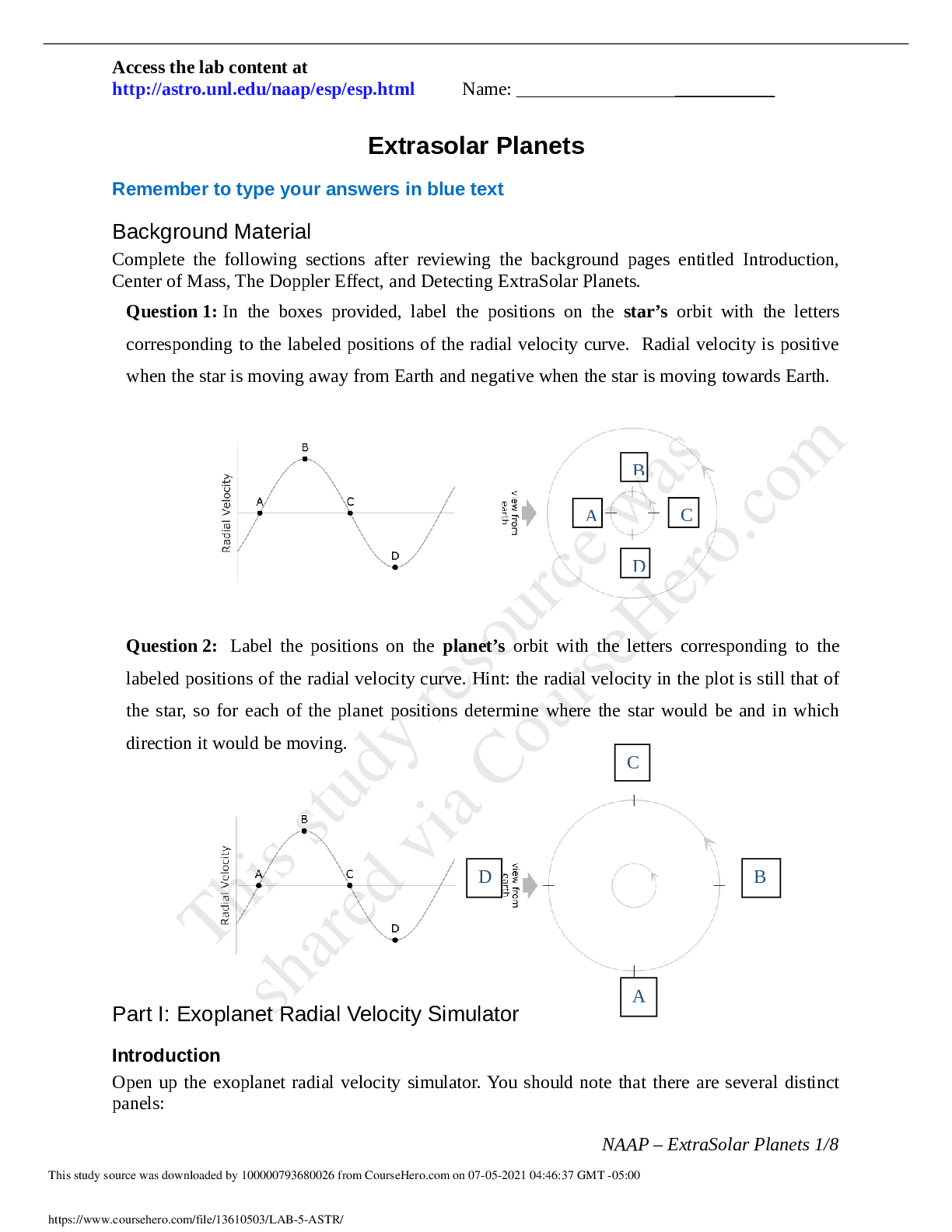Astronomy > Lab Experiment > Spokane Falls Community College ASTRONOMY 101 LAB 5 Extrasolar Planets (All)
Spokane Falls Community College ASTRONOMY 101 LAB 5 Extrasolar Planets
Document Content and Description Below
Extrasolar Planets Remember to type your answers in blue text Background Material Complete the following sections after reviewing the background pages entitled Introduction, Center of Mass, The Do... ppler Effect, and Detecting ExtraSolar Planets. Question 1: In the boxes provided, label the positions on the star’s orbit with the letters corresponding to the labeled positions of the radial velocity curve. Radial velocity is positive when the star is moving away from Earth and negative when the star is moving towards Earth. Question 2: Label the positions on the planet’s orbit with the letters corresponding to the labeled positions of the radial velocity curve. Hint: the radial velocity in the plot is still that of the star, so for each of the planet positions determine where the star would be and in which direction it would be moving. Part I: Exoplanet Radial Velocity Simulator Introduction Open up the exoplanet radial velocity simulator. You should note that there are several distinct panels: NAAP – ExtraSolar Planets 1/8 B C D A C D B a 3D Visualization panel in the upper left where you can see the star and the planet (magnified considerably). Note that the orange arrow labeled earth view shows the perspective from which we view the system. o The Visualization Controls panel allows one to check show multiple views. This option expands the 3D Visualization panel so that it shows the system from three additional perspectives. a Radial Velocity Curve panel in the upper right where you can see the graph of radial velocity versus phase for the system. The graph has show theoretical curve in default mode. A readout lists the system period and a cursor allows you to measure radial velocity and thus the curve amplitude (the maximum value of radial velocity) on the graph. The scale of the y-axis renormalizes as needed and the phase of perihelion (closest approach to the star) is assigned a phase of zero. Note that the vertical red bar indicates the phase of the system presently displayed in the 3D Visualization panel. This bar can be dragged and the system will update appropriately. There are three panels which control system properties. o The Star Properties panel allows you to control the mass of the star. Note that the star is constrained to be on the main sequence – so the mass selection also determines the radius and temperature of the star. o The Planet Properties panel allows you to select the mass of the planet, the semimajor axis, and the eccentricity of the orbit. o The System Orientation panel controls the two perspective angles. Inclination is the angle between the Earth’s line of sight and the plane of the orbit. Thus, an inclination of 0º corresponds to looking directly down on the plane of the orbit and an inclination of 90º is viewing the orbit edge on. Longitude is the angle between the line of sight and the long axis of an elliptical orbit. Thus, when eccentricity is zero, longitude will not be relevant [Show More]
Last updated: 2 years ago
Preview 1 out of 8 pages

Buy this document to get the full access instantly
Instant Download Access after purchase
Buy NowInstant download
We Accept:

Reviews( 0 )
$9.00
Can't find what you want? Try our AI powered Search
Document information
Connected school, study & course
About the document
Uploaded On
Jul 05, 2021
Number of pages
8
Written in
Additional information
This document has been written for:
Uploaded
Jul 05, 2021
Downloads
0
Views
172













